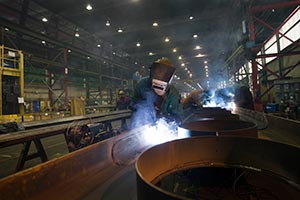Factory Output Stalls in April on Machinery Cutbacks

Factory production stalled in April, as American manufacturers were dealt blows by a strong dollar and cheap oil.
The unchanged reading in manufacturing followed a 0.3% March gain that was larger than previously estimated, a Federal Reserve report showed May 15 in Washington. The median forecast in a Bloomberg News survey of 21 economists called for a 0.2% increase. Total industrial production declined for a fifth consecutive month amid mining and utilities cutbacks.
Soft export demand, caused by a stronger dollar and weaker global markets, continued to diminish U.S. manufacturing activity in April, while oil companies curtailed operations to cope with low fuel prices. The effects of temporary setbacks in the first quarter, including bad weather and a West Coast port shutdown, will probably fade, signaling the industry could make some progress in coming months.
“Manufacturing activity has stabilized but is not rebounding significantly as of yet,” Russell Price, a senior economist at Ameriprise Financial Inc. in Detroit, said before the report. With calmer weather and a resolution of the port dispute, “we expect to see a modest improvement in the pace in the months ahead.”
Another report May 15 showed manufacturing in the New York region expanded at a slower pace this month than projected. The Federal Reserve Bank of New York’s Empire State index climbed to 3.1, just shy of the 5 median forecast of economists surveyed by Bloomberg, from minus 1.2 in April. Readings greater than zero signal growth.
Total industrial production declined 0.3% for a second month. It was projected to be unchanged, according to the Bloomberg survey of 83 economists. Estimates ranged from a drop of 0.7% to a 0.8% gain. Output in March was revised from a previously reported 0.6% drop.
Mining production, which includes oil drilling, decreased 0.8% in April, the fourth consecutive decline. Oil and gas well drilling dropped 14.5%, according to the figures.
Utility output declined 1.3% after plunging 5.4% the previous month.
Automaking remained a bright spot. Output of motor vehicles and parts increased 1.3% after rising 4.3% a month earlier. Excluding autos and parts, factory production declined 0.1% in April after climbing 0.1% a month before.
Capacity utilization, which measures the amount of a plant that is in use, fell to 78.2% last month from 78.6% in March.
U.S. Steel, the country’s second-biggest steelmaker, posted a surprise loss in the first quarter and cut its full-year profit forecast as rising imports put pressure on prices and prompted the Pittsburgh-based company to idle capacity.
“We have a significant presence in the energy business and the flat-rolled segment is the sole supplier to the energy business,” CEO Mario Longhi said on a conference call April 29, referring to U.S. Steel’s flat-rolled unit, its largest business.
The U.S. steel industry used 73% of its capacity on average in the first quarter, down from 77% a year earlier, according to data from the American Iron and Steel Institute.
Machinery production dropped 0.9% last month, while construction materials climbed 0.1%, the Fed report showed.
Other data indicate manufacturing’s slump may be drawing to a close. A gauge of bookings at U.S. factories reached a four-month high in April, according to a report from the Institute for Supply Management earlier this month.
The group’s new orders gauge climbed to 53.5 in April from 51.8 as 35% of purchasing managers surveyed, the biggest share since November, said demand was improving. A measure of production rose to 56 from 53.8, while the export index also advanced.



